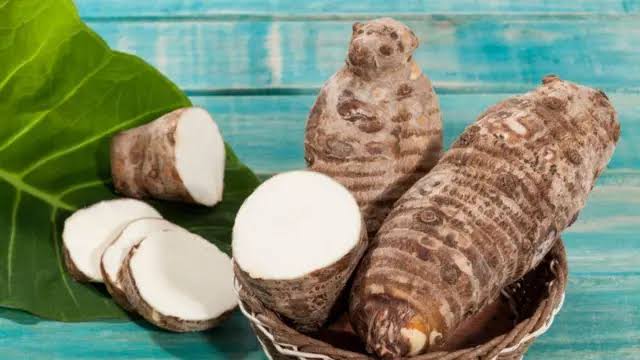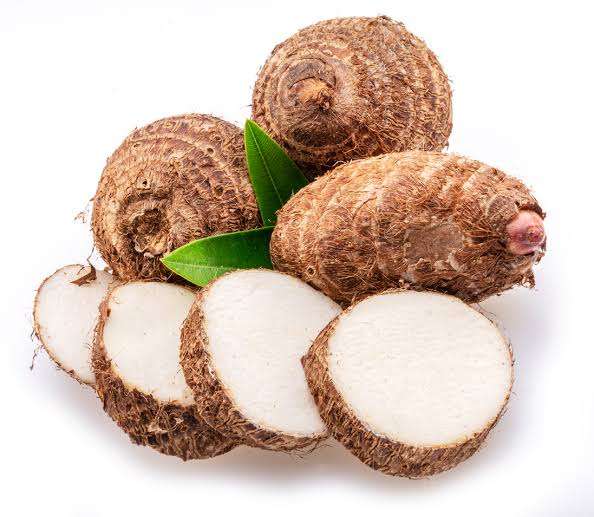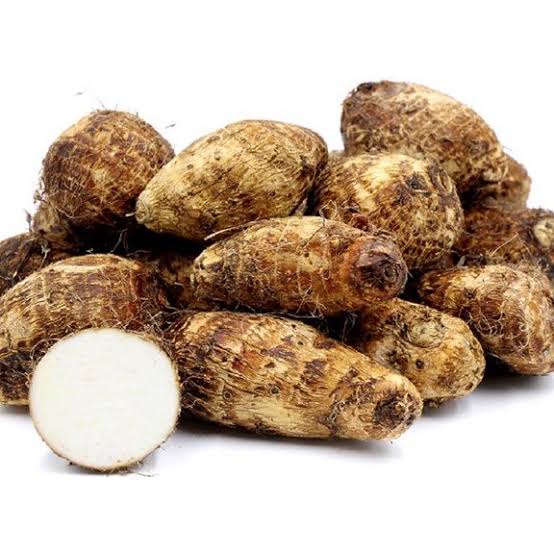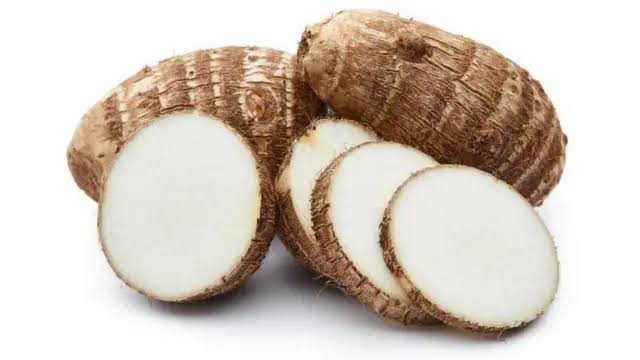Cocoyam, known scientifically as Colocasia esculenta, is a tropical plant widely cultivated for its starchy corms and leaves. Commonly found in Africa, Asia, and parts of the Pacific, cocoyam is also referred to by various names, including taro, eddo, and dasheen.
This versatile crop has been a staple food source in many cultures for centuries, celebrated not only for its culinary uses but also for its impressive nutritional profile.
The plant thrives in moist, warm climates, and its large heart-shaped leaves are often used in traditional dishes. The corms, which grow underground, are the primary edible parts of cocoyam.
These tubers come in different varieties, with colors ranging from white to purple and textures that can vary from smooth to rough. In many regions, cocoyam is often boiled, roasted, or mashed, providing a rich, nutty flavor that enhances a variety of dishes.
Cocoyam is known for its rich carbohydrate content, making it an excellent energy source. The starchy corms are primarily composed of complex carbohydrates, which provide a steady release of energy when consumed.
This quality makes cocoyam an ideal food for individuals needing sustained energy throughout the day, such as laborers or athletes. Unlike simple carbohydrates, which can lead to rapid spikes in blood sugar, the complex carbohydrates in cocoyam are digested more slowly, promoting a feeling of fullness and helping to regulate blood sugar levels.
In addition to carbohydrates, it is also rich in dietary fiber, which is essential for maintaining good digestive health. Fiber aids in promoting regular bowel movements, preventing constipation, and supporting overall gut health. A diet high in fiber can also help lower cholesterol levels and reduce the risk of heart disease.
The fiber content in it is particularly beneficial for those looking to manage their weight, as it helps to increase satiety and curb overeating. Another significant nutritional benefit of cocoyam is its vitamin and mineral content.
Cocoyam is an excellent source of vitamins such as vitamin C and several B vitamins, including B6, B1 (thiamine), and B3 (niacin). Vitamin C plays a crucial role in boosting the immune system, helping the body fend off infections and illnesses. B vitamins are essential for energy metabolism, brain function, and the production of red blood cells, contributing to overall health and vitality.
Moreover, cocoyam is rich in essential minerals such as potassium, magnesium, and phosphorus. Potassium is vital for maintaining healthy blood pressure levels and proper muscle and nerve function.
It helps to balance fluids in the body, which is essential for overall hydration. Magnesium plays a critical role in over 300 biochemical reactions in the body, including muscle and nerve function, blood sugar control, and bone health. Phosphorus is essential for strong bones and teeth, as well as for energy production and storage.
Cocoyam is also recognized for its antioxidant properties, which are attributed to the presence of phenolic compounds and flavonoids. Antioxidants help combat oxidative stress in the body, reducing the risk of chronic diseases such as heart disease, diabetes, and certain cancers. By neutralizing harmful free radicals, it contributes to overall health and well-being.
The versatility of cocoyam in the kitchen adds to its appeal. It can be used in a variety of dishes, from soups and stews to side dishes and desserts. In many cultures, cocoyam is mashed and served similarly to mashed potatoes, or it can be sliced and fried for a crunchy snack.
The leaves of the cocoyam plant are also edible and can be used in cooking, often incorporated into dishes like stews or wraps. When cooked, cocoyam leaves have a slightly earthy flavor and a tender texture, making them a delicious addition to many recipes.
In addition to its culinary uses, it has cultural significance in various communities. In some regions, it is used in traditional ceremonies and celebrations, symbolizing fertility and abundance. It is often offered as food during important rituals and gatherings, reinforcing its role as a vital food source within the community.
The health benefits of cocoyam extend beyond basic nutrition. For individuals with certain dietary restrictions, such as those who are gluten intolerant or seeking alternatives to wheat, cocoyam serves as an excellent substitute. Its naturally gluten-free nature makes it suitable for those looking for gluten-free options without sacrificing flavor or texture.
Furthermore, cocoyam has been used in traditional medicine in various cultures. Some communities utilize the plant for its potential health benefits, believing it can help with conditions such as diarrhea and digestive issues. The leaves have also been used in herbal remedies for their anti-inflammatory properties, promoting overall health and wellness.
In recent years, there has been a growing interest in cocoyam as a functional food due to its nutritional profile and health benefits. As people become more conscious of their dietary choices, cocoyam’s unique properties and versatility have gained recognition as an important food source that can contribute to a healthy diet.
Read Also: The Importance of Sustainable Harvesting and Ethical Sourcing
Culinary and Industrial Uses of Cocoyam

Culinary Uses of Cocoyam
Cocoyam is a staple ingredient in many tropical cuisines, particularly in West Africa, Southeast Asia, and the Pacific Islands. Its culinary versatility allows it to be prepared in a multitude of ways, making it a valuable food source for many communities. Here are some of the most common culinary uses of cocoyam:
1. Boiling and Mashing: One of the simplest and most popular methods of preparing cocoyam is by boiling the corms until they are tender. Once cooked, the corms can be mashed into a smooth or chunky texture, similar to mashed potatoes. This dish can be served as a side dish or as a base for various sauces, stews, and gravies.
2. Frying: It can be sliced into thin rounds or sticks and fried to create a crispy snack. Fried cocoyam chips are a popular snack in many regions, often seasoned with spices or served with dips. The frying process enhances the flavor and texture of the cocoyam, making it a delicious alternative to potato chips.
3. Baking: Baked cocoyam dishes, such as casseroles or gratins, are popular in many cultures. The corms can be sliced and layered with other ingredients like cheese, vegetables, and spices before baking in the oven. This method creates a hearty and flavorful dish that is often served at gatherings and special occasions.
4. Soups and Stews: It is commonly used as a thickening agent in soups and stews. When cooked down, it releases starches that help create a creamy texture, enhancing the overall flavor of the dish. In many African and Caribbean cuisines, cocoyam is added to soups, where it absorbs the flavors of the broth and contributes to a rich, hearty meal.
5. Fermented Products: In some cultures, it is fermented to create traditional foods. Fermentation enhances the nutritional profile and digestibility of the cocoyam while imparting unique flavors. The fermented product can be used to make beverages or incorporated into various dishes, showcasing the versatility of this root vegetable.
6. Cocoyam Leaves: The leaves of the cocoyam plant are also edible and highly nutritious. They can be used in a variety of dishes, such as wraps, stews, and salads. In some cultures, the leaves are steamed or cooked in coconut milk to create flavorful dishes. The leaves are rich in vitamins and minerals, making them a valuable addition to the diet.
Industrial Uses of Cocoyam
Beyond its culinary applications, it is also utilized in various industrial processes. Its unique properties and high starch content make it a valuable resource in several industries. Here are some notable industrial uses of cocoyam:
1. Starch Production: It is rich in starch, which can be extracted and processed for various industrial applications. The starch derived from the cocoyam is used in the food industry as a thickening agent, stabilizer, or gelling agent in products like sauces, soups, and gravies. Additionally, the starch is used in the production of snacks, baked goods, and other food items.
2. Animal Feed: It can be processed into animal feed, providing an alternative source of carbohydrates for livestock. The high energy content of cocoyam makes it suitable for feeding poultry, pigs, and other farm animals. Using cocoyam in animal feed helps reduce feed costs and promotes sustainable agricultural practices.
3. Biodegradable Packaging: The starch extracted from cocoyam can also be used to produce biodegradable packaging materials. As the world seeks more sustainable solutions to plastic waste, cocoyam starch provides an eco-friendly alternative for creating packaging that decomposes naturally, reducing environmental impact.
4. Cosmetics and Personal Care Products: Cocoyam starch has applications in the cosmetics industry as well. Its thickening properties make it an ideal ingredient in various personal care products, such as lotions, creams, and powders. The starch can help improve the texture and consistency of these products, making them more appealing to consumers.
5. Pharmaceutical Applications: Cocoyam is also being explored for its potential use in pharmaceutical formulations. The starch from it can serve as a binding agent in tablet formulations or as a stabilizer in liquid medications. Its biocompatibility and natural origin make it an attractive option for the pharmaceutical industry.
Read Also: Benefits of Utazi Leaf
The Health Benefits of Cocoyam

1. Digestive Health: One of the significant health benefits of cocoyam is its ability to support digestive health. The dietary fiber present helps regulate bowel movements and prevents constipation by adding bulk to the stool. Fiber is essential for a healthy digestive system, as it promotes regularity and reduces the risk of gastrointestinal disorders. Additionally, it contains resistant starch, which acts as a prebiotic, providing nourishment for beneficial gut bacteria and enhancing gut health.
2. Blood Sugar Management: Cocoyam may also help regulate blood sugar levels, making it a suitable option for individuals with diabetes or those at risk of developing the condition. The complex carbohydrates are digested slowly, leading to a gradual release of glucose into the bloodstream. This slow release helps prevent spikes in blood sugar levels, promoting better glycemic control. Furthermore, the high fiber content contributes to stable blood sugar levels by slowing down the absorption of sugars.
3. Weight Management: For those looking to manage their weight, this tuber can be a valuable addition to a balanced diet. The fiber content promotes feelings of fullness, helping to reduce overall caloric intake. Foods rich in fiber are often more satisfying, which can curb hunger and prevent overeating. Additionally, cocoyam is relatively low in fat, making it a healthy and nutritious choice for maintaining a healthy weight.
4. Heart Health: It is beneficial for heart health due to its high potassium content. This crucial mineral helps regulate blood pressure by balancing sodium levels in the body. Consuming potassium-rich foods can contribute to lowering blood pressure and reducing the risk of cardiovascular diseases. The fiber in this root vegetable also plays a role in heart health by helping to lower cholesterol levels, promoting overall cardiovascular well-being.
5. Antioxidant Properties: Rich in antioxidants, including phenolic compounds and flavonoids, cocoyam helps protect the body from oxidative stress and inflammation. Oxidative stress occurs when there is an imbalance between free radicals and antioxidants in the body, leading to cellular damage and contributing to chronic diseases. The antioxidants present help neutralize free radicals, reducing the risk of conditions such as heart disease, cancer, and neurodegenerative disorders.
6. Immune System Support: The vitamin C content plays a significant role in supporting the immune system. Vitamin C is essential for tissue growth and repair, as well as for collagen production, which is vital for skin health. Moreover, vitamin C acts as an antioxidant, helping to protect the body from infections and diseases. Regular consumption can contribute to a strengthened immune response and overall health.
7. Bone Health: Cocoyam is also a good source of essential minerals like calcium and magnesium, which are crucial for maintaining strong and healthy bones. Calcium is necessary for bone formation and density, while magnesium plays a vital role in calcium absorption and metabolism.
8. Skin Health: The antioxidant properties can also benefit skin health. Vitamin C aids in collagen production, which is essential for maintaining skin elasticity and firmness. Additionally, the anti-inflammatory properties may help soothe skin irritations and conditions such as acne or eczema. Regular consumption can promote a healthy complexion and overall skin health.
9. Potential Anti-Inflammatory Effects: Some studies suggest that cocoyam may possess anti-inflammatory properties, which can be beneficial for managing chronic inflammation in the body. Chronic inflammation is linked to various health conditions, including heart disease, diabetes, and arthritis. The compounds found in this root vegetable may help reduce inflammation, promoting better overall health and potentially lowering the risk of inflammatory-related diseases.
10. Culinary Versatility: Incorporating cocoyam into the diet is easy due to its culinary versatility. It can be boiled, mashed, baked, or fried, and is often used in soups, stews, and casseroles. The leaves of the plant are also edible and nutritious, adding another layer of health benefits. This versatility makes it an excellent choice for adding variety to meals while reaping its numerous health benefits.
Frequently Asked Questions on the Uses and Benefits of Cocoyam

1. What is cocoyam, and where does it come from?
Cocoyam, scientifically known as Colocasia esculenta, is a starchy tuber native to Southeast Asia and the South Pacific. It is widely cultivated in tropical and subtropical regions, including Africa, where it is a staple food. It is known for its rich flavor and nutritional content, making it a valuable addition to many diets.
2. What are the nutritional benefits of cocoyam?
It is rich in carbohydrates, dietary fiber, vitamins, and minerals. It is an excellent source of vitamin C, vitamin B6, potassium, and magnesium. The fiber content aids digestion, promotes a healthy gut, and helps regulate blood sugar levels.
3. How is cocoyam prepared for consumption?
It can an be prepared in various ways, including boiling, steaming, baking, or frying. It can be mashed, added to soups and stews, or used as a thickener for sauces. The leaves of the cocoyam plant are also edible and can be used in salads, cooked dishes, or wrapped around fillings for steaming.
5. Are there any health benefits of cocoyam for digestion?
Cocoyam is high in dietary fiber, which is essential for healthy digestion. The fiber helps bulk up stool, making it easier to pass and reducing the risk of constipation.
7. Can cocoyam be used in gluten-free diets?
Absolutely! It is naturally gluten-free, making it an excellent alternative for those with gluten sensitivities or celiac disease. It can be used in place of wheat flour in various recipes, providing a nutritious option for baked goods and other dishes.
8. What are the medicinal uses of cocoyam?
Cocoyam has traditionally been used in herbal medicine for various purposes, including treating digestive issues, skin conditions, and inflammatory diseases. The anti-inflammatory properties of cocoyam may help alleviate symptoms associated with arthritis and other inflammatory conditions.
9. How does it benefit the skin?
It contains antioxidants and vitamins that can promote skin health. The high vitamin C content aids in collagen production, improving skin elasticity and reducing signs of aging.
10. Are there any potential side effects of consuming cocoyam?
While it is generally safe for most people, it should be consumed in moderation. Raw cocoyam contains calcium oxalate, which can cause irritation in the mouth and throat. Cooking it thoroughly helps to reduce these compounds, making it safe to eat. Those with kidney stones or certain dietary restrictions should consult a healthcare professional before consuming large quantities.
11. Can cocoyam be beneficial during pregnancy?
It can be beneficial during pregnancy due to its high nutrient content. The vitamins and minerals support the health of both the mother and the developing fetus. However, pregnant women should ensure that cocoyam is well-cooked to avoid any potential irritation from raw compounds.
13. Where can I find cocoyam?
It can typically be found in local markets, grocery stores, or specialty stores that sell tropical produce. It is often available fresh, but you may also find dried or processed forms in some locations.
14. What is the difference between cocoyam and taro?
Cocoyam and taro are often confused due to their similarities, but they are different plants. While both belong to the same family (Araceae), cocoyam (Colocasia esculenta) is distinct from taro (Colocasia antiquorum). They have slightly different textures and flavors, with cocoyam being creamier when cooked.
15. Can it be stored for long periods?
Fresh cocoyam should be stored in a cool, dry place, away from direct sunlight. When stored properly, it can last for several weeks. If you need to keep it for a longer period, consider cooking it and then freezing it, which can extend its shelf life while preserving its nutrients.
Read Also: Low-Maintenance Plants for Beginners
Do you have any questions, suggestions, or contributions? If so, please feel free to use the comment box below to share your thoughts. We also encourage you to kindly share this information with others who might benefit from it. Since we can’t reach everyone at once, we truly appreciate your help in spreading the word. Thank you so much for your support and for sharing!

